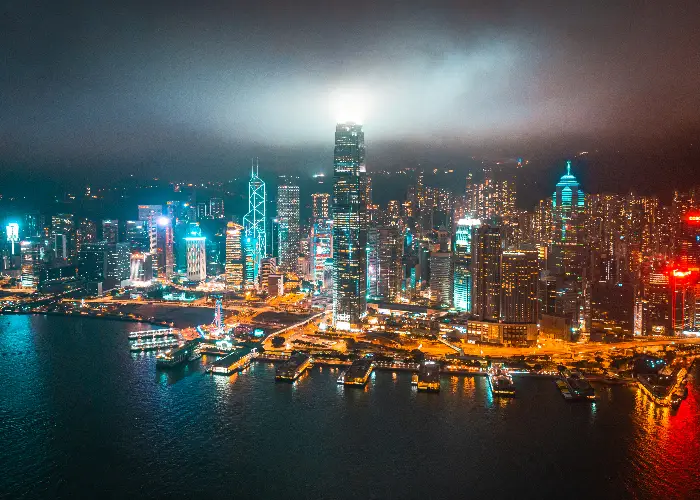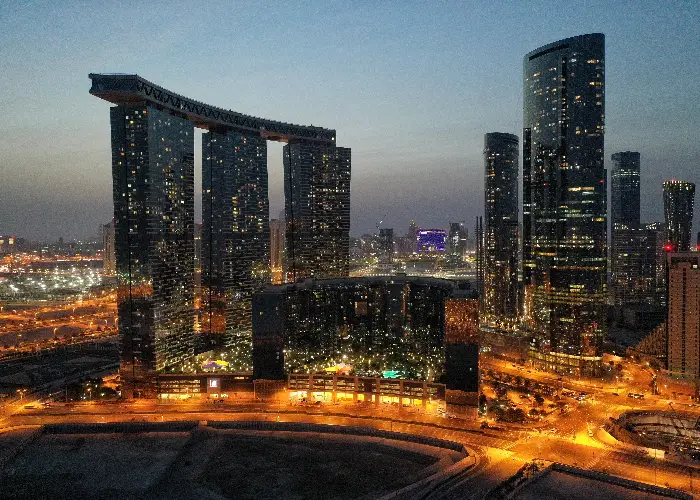Introduction: Harnessing Feng Shui in High-Altitude Living
Have you ever watched the sun cast its first light from your sky-high habitat in one of those mammoth skyscrapers, brewing a cup of coffee as city life slowly wakes beneath you? It’s nothing short of magical. But did you know this seemingly perfect urban dream could be impacted by Feng Shui?
Yes, Feng Shui – the age-old Chinese practice that talks about harmony and flow of energy, it applies even to your modern penthouse on the 87th floor. Now imagine, if mere furniture placement or wrong color tones could disrupt this energy balance then what impact a towering skyscraper might have on Feng Shui? Intriguing isn’t it?
This thought brings us to our main discussion: Bad Feng Shui in skyscrapers and its impact on our day-to-day experience. Together we’ll discover how high-altitude living can uncover unique challenges in harnessing positive chi (energy), and explore solutions to ensure your corner in the sky remains a harmonious sanctuary. Buckle up; it’s going to be an enlightening ride!

Recognizing Bad Feng Shui in Skyscrapers
While the breathtaking views and modernity of skyscraper living can be enticing, they sometimes come with unwanted Feng Shui drawbacks that we may overlook. One of the primary aspects to recognize is the overbearing size and height of these structures. According to Feng Shui principles, enormous heights can disrupt the harmony between earth and sky, creating an imbalance in energy flow.
Next, look into your home’s layout – long corridors leading to your apartment door or a direct alignment of front and back doors are seen as negative in Feng Shui as they accelerate Chi’s flow beyond desired levels. And those elevator doors directly facing your main entrance? They’re not considered auspicious either.
High-rises surrounded by taller buildings tend to suffer from Sha Chi or attacking energy which may manifest in hurdles and struggles for its residents. The proximity to large infrastructural elements like overhead bridges, expressways, or even electric power stations is another red flag for poor Feng Shui.
Lastly, pay heed to prominent architectural features within your apartment like sharp corners pointing towards living areas or bedrooms (known as poison arrows), irregular-shaped rooms leading to incomplete sectors based on bagua -the energy map-, missing corners due to cut-outs for elevators shafts staircases etc., all contributing towards bad Feng shui.
By being aware of these issues specific in skyscrapers we’ve taken our first essential step in navigating our way around bad feng shui! In upcoming sections let’s delve into further impacts these might have on us & how we can mitigate them effectively.
Impacts of Poor Building Design on Feng Shui
The influence of bad building design on Feng Shui is significantly impactful, shaping how energy flows around us and our daily experiences. Let’s understand this in depth.
Poor building design, especially in skyscrapers, can create a disconnection between the environment and occupants. This disconnect interrupts the dynamic flow of beneficial Chi resulting often, in stifled opportunities or stagnation areas life. The imbalance may manifest as difficulties in career advancement, a strained social circle or even influencing overall mood and well-being.
Take overly tall buildings for instance; they disrupt the natural balance between heaven (Sky Chi) and earth (Earth Chi). Occupants residing on higher floors may experience heightened anxiety or difficulty grounding themselves due to an over-representation of Sky Chi.
Specific apartment layouts harbour further issues – elongated corridors act like fast-moving rivers of energy pushing away positive chi from your doorstep while direct alignment of doors could lead to missed opportunities– symbolising auspicious chi rushing through without dwelling within your home.
Architectural flaws within apartments such as Sha-Chi inducing objects like sharp corners called “poison arrows” targeting at living areas can trigger conflicts among house members or illnesses respectively.
Moreover structures nearby like expressways reflect chaotic rushing energies which possibly correlates with disrupted sleep patterns if bedroom windows face them directly.
Understanding these impacts qualifies your perception beyond aesthetics when scrutinizing apartments ensuring that your sky-high haven doesn’t morph into an unwanted mightmare just because Feng Shui took back seat during its design phase!

Common Feng Shui Obstacles in Skyscrapers
Familiarizing ourselves with the most common Feng Shui obstacles in skyscrapers enables us to counterbalance negatives for a harmonious living environment. So, what exactly are these barriers within towering constructs?
Foremost among these is the structural proportions of high-rises themselves. Dramatically tall buildings fall outside the spectrum of human scale, potentially making inhabitants feel insignificant or overwhelmed. To combat this, aim to create a homely environment that radiates warmth and comfort within your apartment.
Next on our radar is multiple or mirrored doors and windows that proliferate in modern complex designs. Such features can speed up chi flow excessively or result in constant energy reflections causing instability or restlessness at home.
Have you noticed how apartments tend to have tight conners due to practical architectural constraints? These emit ‘Sha Chi’ (killing Chi), which if directed at main areas of activity like bed, desk, etc., could cause health issues & conflicts between family members.
Altered layouts with missing sectors -imagine apartments flanking either side of elevator shafts having angled living rooms- another prevalent obstacle disturbing energy balance causing incomplete representation (and thus luck) across various life aspects as per Bagua mapping.
Even inadequate natural light invasion into high-rise homes is a bane – it’s an essential component for positive Feng Shui promoting health & growth aspects alike!
By identifying such common problems we equip ourselves with knowledge allowing solution-oriented thinking when dealing or residing within skyscraper environments conducive for our overall well-being through balanced energies!
Correcting Bad Feng Shui in your Skyscraper Home
Fear not, tower dwellers! Turning bad Feng Shui around in your skyscraper home is achievable with a few mindful corrections. The first step is to harmonize Sky chi and Earth chi. Keep houseplants or use earth-toned decor to bring in grounding elements of nature into high altitude spaces.
For long, accelerated Chi-flow inducing corridors leading to your home place art pieces, rugs or other decor elements strategically slowing down the rush of energy and gently guiding it into your abode. Similarly if the alignment of doors allows Chi to fly straight from entrance through back door; screens, curtains or furniture placement can disorder such direct line creating meandering paths for energy flow.
Diffuse ‘Sha Chi’ emanating from sharp corners with soft fabrics furnishing can incorporate rugs that visually divide a room or place plants near sharp edges – acting as buffer against these so-called poison arrows.
As modern designs often involve mirrored surfaces causing chaotic reflections within houses using more matte finish items vs reflective counterparts would reduce this imbalanced state.
A Bagua mirror outside apartments having immediately facing elevators would deflect some incoming rushed energies thereby protecting internal balance within homes.
Adjust lighting conditions if limited natural light invades apartment spaces switch them out for lights whose spectrum closely mimic natural daylight nor too harsh neither too lowly lit creating a balanced inviting environment indoors!
With attention detail knowledge you have stand front foot taking corrective measures ensuring holistic positive impact countering detrimental forces contemporary high-rise lifestyle typically brings along! Let’s work on embracing Feng Shui friendly skyscraper living.

How to Avoid Bad Feng Shui when Choosing an Apartment
When searching for a new apartment in the sky, keeping Feng Shui principles at the forefront can ensure you don’t unknowingly walk into bad energy flow. Start by avoiding buildings sandwiched between taller structures these potentially channel ‘Sha Chi’, creating obstacles in your path to success and happiness.
Pay attention to the building’s surrounding external elements. Try to avoid close proximity to chaotic infrastructures like highways or power stations, as they can push aggressive energies towards your potential home.
Take note of the immediate layout once entering an apartment – if doors directly align or if staircases/elevators face apartments’ main entry it’s a Feng Shui disadvantage signifying fast exit of good energy from households.
Observe interior shapes – irregular or missing corners due to architectural designs may disrupt balanced Chi circulation affecting specific life aspects mapped on Bagua grid ranging from financial luck right up till relationships!
In terms of floor level selection, those too high amplify Sky Chi causing imbalance while lower floors may lack sufficient light essential positive energies; strike balance choosing middle floors where possible within high-rises!
Finally during home inspections pay close attention roomali gements occurrences repetitive numberings (e.g., similar door numbers) which could indicate preconceived patterns influencing potential living experiences.
Remember – just because an apartment is breathtakingly stylish doesn’t mean it has great Feng Shui! Being informed & aware helps you choose wisely so that your new address isn’t just aesthetically gratifying but also energetically uplifting!
Case Studies of Feng Shui Transformed Residential Skyscrapers
Examining how Feng Shui practices have transformed residential skyscrapers around the world adds another layer to our understanding. One striking case involves the Pearl River Tower in Guangzhou, China, which was meticulously planned alongside Feng Shui masters. Its aerodynamic shape ensures Chi smoothly flows around it rather than being obstructed and its elevated base allows Qi from nearby river to pass under promoting prosperity.
Another fascinating example is New York’s Time Warner center dual high-rises where architects incorporated a gap between two towers allowing free flow of energy per Feng Shui recommendations; residents lauded improved overall well-being post modifications!
A Singapore based architectural firm redesigned an entire floor plan for a penthouse right before construction ensuring good energy circulation that would otherwise have been affected due to irregular floor layout missing building support pillars interspersed throughout.
Meanwhile a luxury condominium project in Vancouver embraced Feng Shui principles during design stages – their central courtyard encouraging Chi flow, round-edged towers curbing Sha-Chi & dampening water features every odd numbered floors balance Yin-Yang amicably!
Further east, Tokyo’s Shibuya Parco dept.store tower utilizes radical approach – entire tower shaped like Kanji character ‘Kokoro’ (heart) indicating holistic approach towards each resident’s life aspects providing customized solutions fostering positive energies among dwellers within!
These instances highlight expert utilization of specific designs & décor elements facilitating Chi movement correcting inherent modern architectural challenges along commercial interests considering lifestyle wellness across global high-rise communities extending benefits beyond mere aesthetics invoking natural harmony.
Conclusion: Overcoming Feng Shui Challenges in Skyscraper Living
In our exploration of Feng Shui within skyscraper living, it’s clear to see that modern high-rises offer their own unique set of challenges. From recognizing bad Feng Shui characteristics like speed-chi corridors and Sha-Chi inducing structures, dealing with design-induced problems such as missing Bagua sectors or overrepresentation of Sky Chi in deceitfully glamorous penthouses, to understanding how these negatively impact daily experiences – we’ve covered quite a journey!
However, by educating ourselves about these issues and making thoughtful adjustments at home as well as during apartment selection process, we can certainly navigate towards better energy flow despite design constraints typical to skyscrapers.
Success stories worldwide involving harmonious blend of ancient wisdom right into contemporary architecture further inspire us towards this goal ensuring comfort & prosperity regardless height above ground.
Remember: A house is not simply made up of walls and furniture– it’s composed also the invisible life-force energy coursing through – shaping our health, relationships and overall wellbeing!
Your actions determine whether your high-rise-haven nurtures positive influences or could do with some mindful modifications. No matter where you reside within tall towers – top floor touching skies or snugly nestled somewhere mid-way enjoying city lights from afar; ensure Feng Shui principles guide your space arrangement creating warm buzz throughout your vertical slice under sky! So why wait? Let’s begin transforming chi for our better today!

Sign up